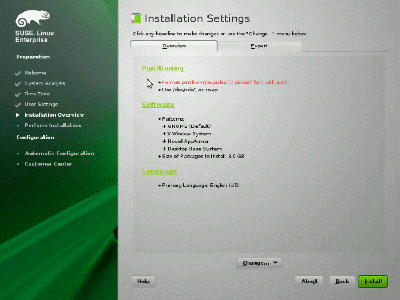SUSE Linux Enterprise 11
Novell's new enterprise Linux
by Alexandra Kleijn
SLE 11 brings Novell's business Linux bang up to date. With the new High Availability Extension, SLE 11 is now fit for clusters, and interoperability is ensured by support for virtualisation technologies Xen, KVM, VMware and Hyper-V.
It's two and half years since Novell released the previous version, Release 10, of SUSE Linux Enterprise and nearly a year since the last update in the form of Service Pack 2. The release of Version 11 brings Novell's SUSE Linux Enterprise up to date.
As well as the usual SUSE Linux Enterprise Server (SLES) and SUSE Linux Enterprise Desktop (SLED) 11 options, the new release also offers two optional extensions for specific objectives: the High Availability Extension makes the server version suitable for cluster deployment and the Mono Extension is aimed at developers who wish to operate a complete .NET environment under Linux.

![]() The SLE 11 installation is tidier than previous versions.
According to Gerald Pfeifer, who is, as Novell's Director of Inbound Product Management, responsible for SLE 11, three major topics converge in SLE 11; interoperability, ubiquity and mission critical computing. SUSE Linux Enterprise Server 11 is targeted at the high availability requirements of data centres and other large customers. This encompasses the High Availability Extension, which uses the OCFS2 cluster file system, and technologies such as Data Centre Bridging (DCB), a collection of Ethernet enhancements which make it possible to send data with different requirements (with regard to, for example, data integrity or low latency) over the network.
The SLE 11 installation is tidier than previous versions.
According to Gerald Pfeifer, who is, as Novell's Director of Inbound Product Management, responsible for SLE 11, three major topics converge in SLE 11; interoperability, ubiquity and mission critical computing. SUSE Linux Enterprise Server 11 is targeted at the high availability requirements of data centres and other large customers. This encompasses the High Availability Extension, which uses the OCFS2 cluster file system, and technologies such as Data Centre Bridging (DCB), a collection of Ethernet enhancements which make it possible to send data with different requirements (with regard to, for example, data integrity or low latency) over the network.
SLE 11 supports 10 Gbit Ethernet, OFED 1.4, Traceroute over TCP and Fibre Channel over Ethernet with an implementation Open-FCoE. Novell has updated its IPv6 support – important in the context of US government requirements. SUSE Linux Enterprise no longer uses ReiserFS as its standard file system, having switched instead to Ext3. The system does, however, still support both ReiserFS3 and XFS. LVM2 (cLVM) replaces EVMS2 as volume manager.
Ext4, the successor to Ext3, is included as a 'technology preview'. Features with technology preview status (with which Novell whets the interest of customers without actually providing any official support) include the KVM virtualisation solution and 'Hot-Add Memory' – the addition of memory during ongoing operation. Administration tool puppet, Internet Storage Naming Service (iSNS), Linux File system Capabilities and the eCryptfs file system, which adds cryptographic functions to a normal file system, are also all designated as technology preview features in SLE.
Next: SUSE Linux Enterprise ubiquity
![Kernel Log: Coming in 3.10 (Part 3) [--] Infrastructure](/imgs/43/1/0/4/2/6/7/2/comingin310_4_kicker-4977194bfb0de0d7.png)

![Kernel Log: Coming in 3.10 (Part 3) [--] Infrastructure](/imgs/43/1/0/4/2/3/2/3/comingin310_3_kicker-151cd7b9e9660f05.png)
















